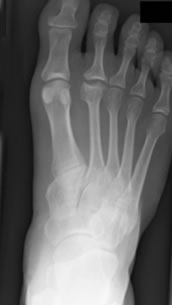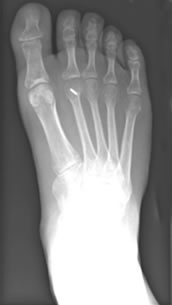in Foot and Ankle Surgery and Reconstruction
This is a term given to a very specific condition most often affecting the end of the 2nd metatarsal bone in the foot. It is not a severe widespread disease, but a condition whereby the head of the metatarsal becomes misshapen and loses its nice round smooth contour. As the end of the bone loses its shape it gradually turns into a “square peg“ trying to fit into a “round socket”. Freiberg was a gentleman who described it in 1914.

It is probably caused by a loss of blood supply to the end of the bone for some reason around puberty. This may be due to repetitive strain on the bone causing subtle damage to the end of the bone near the growth area. As a result it is unable to develop a normal shape and can get quite square at the end.
It is more often seen in women. Symptoms of pain, stiffness and swelling around the affected toe, often the 2nd, can occur in teens or early adulthood. It is usually worse on wearing high heels with pain under the ball of the foot. Patients can sometimes only notice symptoms as they get older.
The clinical features as discussed above in addition to typical X-Ray findings seen below make the diagnosis of Freibergs Disease
Patients often complain of chronic discomfort in the foot. As the symptoms progress the swelling and stiffness can become more noticeable and the patient may develop more of a limp to take weight of the foot.

The treatment is operative or non-operative.
Non-operative treatment aims to reduce the symptoms by reducing the pressure on the painful toe when you are active. This can be through the application of correctly padded insoles or custom-made shoes. This is not a curative option, but may be suitable for some patients. In addition, patients may find taking pain-killers or anti-inflammatory tablets beneficial, provided there are no other medical reasons they cannot take them.
Operative treatment can try to relieve the symptoms by debriding or “tidying up” the joint as there is often significant joint inflammation that can be surgically treated. Another surgical option is to change the position of the deformed part of the metatarsal bone by cutting it and realigning it and holding with a tiny screw. By doing this the surgeon can move the bone to try to make the joint move more smoothly and rather than keeping it as a square peg fitting into a round socket it can turn into a round ball in a socket.
Many patients are simply seeking advice on managing a problem. In mild cases modifying shoes or activities can prove a successful therapy however if non-operative measures have failed to improve symptoms then surgery is indicated, but the timing of the surgery can be arranged to suit your needs. Unfortunately the outcome of surgery is not always predictable. Pain is usually improved but the toe can sometimes remain quite stiff.